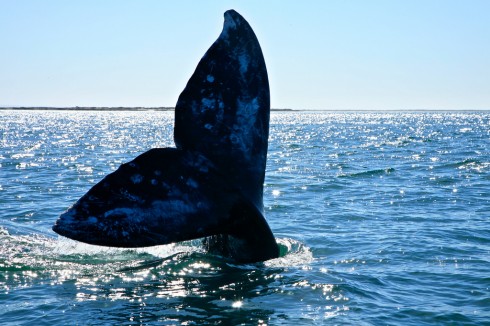| January 3rd, 2018 | | | SofiaBlog |
This time of year, you can mix up the fine dining, theater- and concert- and museum-going, craft-beer tasting, historical sightseeing, and all the other cosmopolitan pleasures of San Diego with absolutely world-class ecotourism.
Right now, huge gray whales—gentle giants of blotchy hide, knobby backs, and baleen grins—are cruising southward to calving and wintering grounds in Baja California, right past the San Diego coast. They’re coming from Alaskan waters: their summertime buffet table. This journey is no mere walk in the (watery) park: It’s a 12,000-mile-long (round-trip) odyssey, one of the greatest animal migrations known.
And you can experience this natural wonder firsthand as a guest of ours at the Sofia Hotel: one of the most auspiciously situated (and all-out welcoming) downtown SanDiego hotels!
Prime Time, Whale-Wise
While you can spot gray whales off our local coast anytime between December and April (by late winter/early spring the leviathans are northbound again, but often farther offshore), January is just about prime time. At Cabrillo National Monument on the Point Loma Peninsula—one of the best vantages for whale-watching in the region—you’ve got an excellent chance of spotting a spout or two by staking out at the Whale Overlook or the Old Point Loma Lighthouse.
“Field Marks” of the Gray Whale
If whales are passing close enough, you can sometimes spot them with the naked eye, but binoculars are a real help; the Visitor Center at Cabrillo lends out a small number. Typically the grays swim beyond the kelp beds, so focus your searching from that border to the skyline. A gray whale’s spout may be 15 feet high, and with a little practice you can begin to distinguish the wispier, puffier look of these “blows” from whitecaps.
That said, calm seas definitely deliver better whale-watching conditions, as do overcast skies: Glinting glare is about as bad as breaking waves when it comes to trying to pick out whales. Because of the position of the sun, morning makes for the most optimum time of day for looking.
As they travel north to south (right to left, to a shorebound observer), the grays usually follow a recognizable swimming rhythm: taking breaths at the surface, then diving for several minutes before coming up for air again. Generally the whales will spout several times, each blow separated by perhaps half a minute or a minute, then go deep for three to six minutes.
The spout is the most conspicuous sign of a gray, and it’s something you can pick out with your peripheral vision. Once you see one, hoist those binoculars and scan slowly left of where the blow faded; hopefully you’ll see the next in sequence—and maybe the whale’s head or ridged back, too—and then be able to track the animal. As the gray dives, you’ll often catch a glimpse of its upraised tail flukes.
If you’re really lucky, you may see a breach: when a whale throws itself into the air and crashes down with a mighty splash. Or perhaps you’ll spot a “spyhop,” the whale raising its prow-like head straight up from the water.
Staff at the Cabrillo National Monument Visitor Center can help you look for the grays; the monument also holds a Whale Watch Weekend in January or February. With its blufftop panorama, meanwhile, the Birch Aquarium at Scripps makes another good shore-based whale-watching perch. The aquarium also leads offshore whale-watching cruises that embark from Downtown San Diego, in case you want to try viewing the grays from their own element.
Catch the Gray Whale Migration During Your Sofia Hotel Stay
So come enjoy fabulous hospitality and amenities right in the heart of America’s Greatest City at the Sofia—the best of the best when it comes to downtown SanDiego hotels—and dedicate a day or two to the spectacular whale-watching going down this time of year along our Pacific doorstep!












